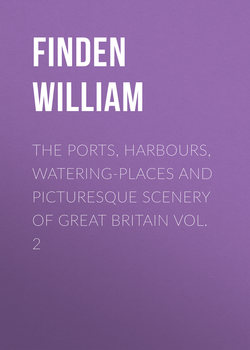Читать книгу The Ports, Harbours, Watering-places and Picturesque Scenery of Great Britain Vol. 2 - Finden William - Страница 7
CONWAY CASTLE, NORTH WALES
Оглавление"Tantôt c'est un vieux fort, qui, du haut des collines,
Tyran de la contrie, effrei de ses vassaux,
Portait jusqu'au ciel l'orgueil de ses crénaux;
Qui, dans ces temps affreux de discorde et d'alarmes,
Vit les grands coups de lance et les noble faits d'armes
De nos preux chevaliers…
Aujourd'hui la moisson flotte sur ses débris."
Conway, or more properly Aberconway – so called from its position on the river of that name – makes no inconsiderable figure in the page of ancient history. It appears, on the testimony of Suetonius, the Roman governor in Britain, that the chief motive entertained by his countrymen in their occupation of this coast was a pearl fishery at the mouth of the river Conway; a specimen of which, presented by Sir R. Wynne to the Queen of Charles the Second, is said to have found a place among the jewels that now adorn the British diadem.
The town of Conway is large, though not populous, and in situation and appearance highly picturesque. It is surrounded by lofty embattled walls, a mile and a half in circumference, well preserved, defended by twenty-four round-towers and four gates, and presenting at all points a striking picture of the ancient style of fortification. From the side towards the river ran two curtain-walls, terminating in watch-towers, but of which only one remains.
The castle, a truly grand and imposing structure, was built in 1284; an epoch which gave origin to so many of those native fortresses, which will long continue to be the subject of interest and admiration to every traveller in this romantic country.
Conway had, unlike Carnarvon and other fortresses situated on a level, no imposing portal to usher into the interior. Its two entrances were small, both practised for security, between an advanced work flanked by two small towers, one ascending by winding stairs from the river, the other, from the interior of the town, crossed the defensive moat by means of a drawbridge, and passed through a portal and outwork of small turrets into the great court of the castle. This stands on a rock, its courts flanked by eight enormous battlemented round-towers of unequalled beauty of proportion, those next the river having in addition small turrets. Of these towers, all are perfect as to their exterior save one, called Twr Dwu, or the broken tower, of which the lower portion, with the rock that supported it, has fallen away, exposing to view the immense solidity of its fractured walls. The interior of each tower was occupied by several stages of spacious apartments, the flooring and roof of which are entirely gone, with the fire-places, and lancet windows, the interior yawning in vacant desolation, blackened, weather-stained, and overgrown with rampant weeds and briers. There were stairs to ascend to the upper apartments from the courts below, and a way round the battlements which may still be followed out. The interior of the castle consists of two courts, comprising the different apartments. As we enter the grassy area, surrounded by ivied walls, and picturesquely surmounted by the battlemented turrets, the great hall appears on the right; three spacious windows of pointed architecture, and formerly highly enriched with mullions and tracery, lighted it on the side next the court, and the side wall, furnished with six lancet windows, with recessed and raised seats, looking out upon the creek, which, running up from the Conway, defended the walls on the south. Two carved fire-places of ample dimensions warmed the immense and royal apartment, supported by several gothic arches, some of which, clothed with ivy, still span the vacant space above, while beneath, among nettles and brambles, yawn the offices below. At the extremity of the hall is a noble arched window. The walls are now mantled thick with ivy, and the nettle and bramble overgrow what remains of the floor of this royal apartment, where Edward, whose statue in Westminster Abbey is of unequalled beauty, and Queen Eleanor, with masque and antique pageantry, entertained the throng of knights and barons bold, who had assisted in the subjugation of the Welsh, who besieged, however, the potent monarch in his own castle, and would have starved him into a surrender, but for the timely arrival of a fleet bearing soldiers and provisions. Since that period, its history is little remarkable. It was held in the civil war, for Charles I., by Archbishop Williams, who, being superseded by Prince Rupert, assisted the Parliamentarians in effecting the reduction of the place.
